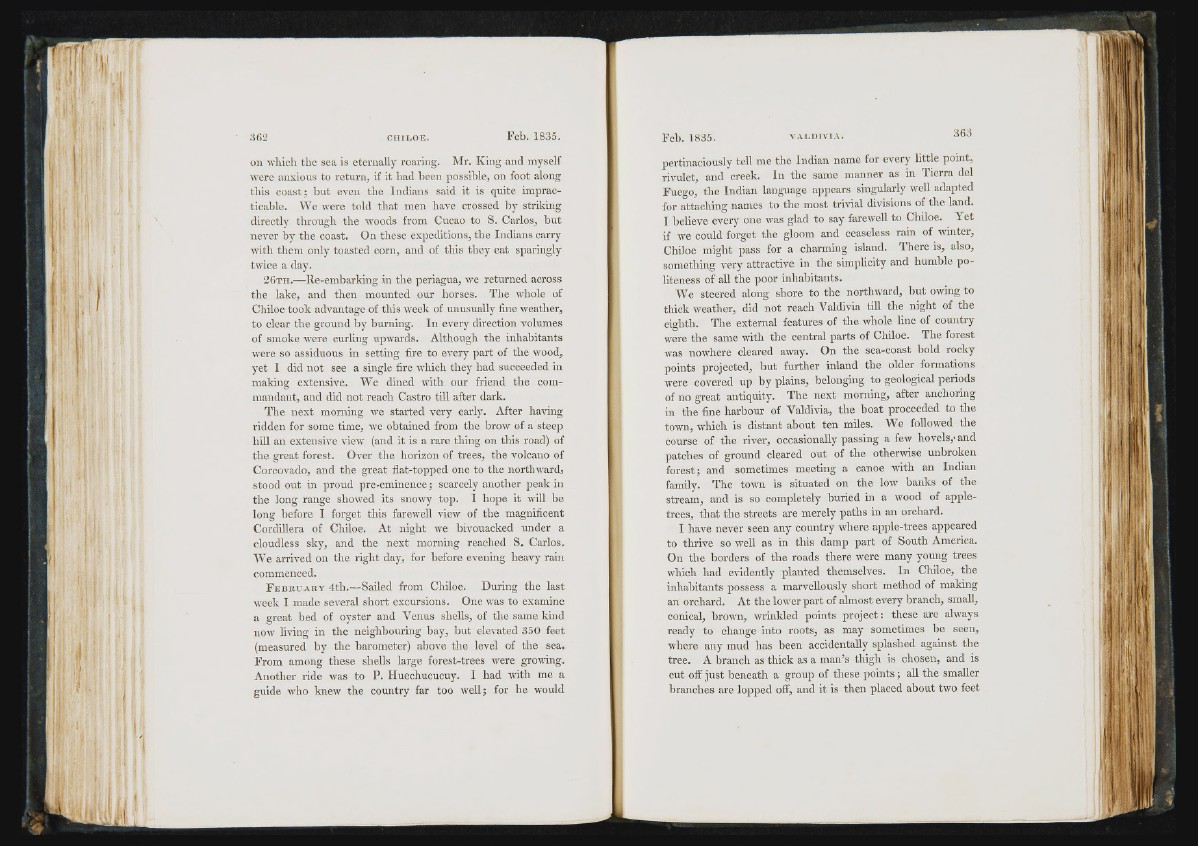
' " ft
on ivhich tlie sea is eternally roaring. Mr. King and myself
were anxious to return, if it had been possible, on foot along
tills coast; but even the Indians said it is quite impracticable.
We were told that men have crossed by striking
directly through the woods from Cucao to S. Carlos, but
never by the coast. On these expeditions, the Indians carry
with them only toasted corn, and of this they eat sparingly
twice a day.
2Gt h .—Re-embarking in the periagua, we returned across
the lake, and then mounted our horses. The whole of
Chiloe took advantage of this week of unusually fine iveather,
to clear the ground by burning. In every direction volumes
of smoke were curling upwards. Although the inhabitants
were so assiduous in setting fire to every part of the wood,
yet I did not see a single fire ivhich they had succeeded in
making extensive. We dined with our friend the commandant,
and did not reach Castro till after dark.
The next morning we started very early. After having
ridden for some time, we obtained from the brow of a steep
hill an extensive view (and it is a rare thing on this road) of
the great forest. Over the horizon of trees, the volcano of
Corcovado, and the great flat-topped one to the northward,
stood out in proud pre-eminence; scarcely another peak in
the long range showed its snowy top. I hope it wiU be
long before I forget this farewell view of the magnificent
Cordillera of Chiloe. At night we bivouacked under a
cloudless sky, and the next morning reached S. Carlos.
We arrived on the right day, for before evening heavy rain
commenced.
F e b r u a r y 4th.—Sailed from Chiloe. During the last
week I made several short excursions. One was to examine
a great bed of oyster and Venus shells, of the same kind
now living in the neighbouring bay, but elevated 350 feet
(measured by the barometer) above the level of the sea.
From among these shells large forest-trees were growing.
Another ride was to P. Huechucucuy. I had with me a
guide who knew the country far too well; for he would
pertinaciously tell me the Indian name for every httle point,
rivulet, and creek. In the same manner as in Tierra del
Fuego, the Indian language appears singularly well adapted
for attaching names to the most trivial divisions of the land.
I believe every one was glad to say farewell to Chiloe. Yet
if we could forget the gloom and ceaseless rain of winter,
Chiloe might pass for a charming island. There is, also,
something very attractive in the simplicity and humble politeness
of all the poor inhabitants.
We steered along shore to the northward, but owing to
thick weather, did not reach Valdivia tiU the night of the
eighth. The external features of the whole line of country
were the same with the central parts of Chiloe. The forest
was nowhere cleared away. On the sea-coast bold rocky
points projected, but further inland the older formations
were covered up hy plains, belonging to geological periods
of no great antiquity. The next morning, after anchoring
in the fine harbour of Valdivia, the boat proceeded to the
town, which is distant about ten miles. We followed the
course of the river, occasionally passing a few hovels,* and
patches of ground cleared out of the otherwise unbroken
forest; and sometimes meeting a canoe with an Indian
family. The town is situated on the low banks of the
stream, and is so completely buried in a wood of apple-
trees, that the streets are merely paths in an orchard.
I have never seen any country where apple-trees appeared
to thrive so well as in this damp part of South America.
On the borders of the roads there were many young trees
which had evidently planted themselves. In Chiloe, the
inhabitants possess a marvellously short method of making
an orchard. At the lower part of almost every branch, small,
conical, brown, wrinkled points project: these are always
ready to change into roots, as may sometimes he seen,
where any mud has been accidentally splashed against the
tree. A branch as thick as a man’s thigh is chosen, and is
cut off just beneath a group of these points; all the smaller
branches are lopped off, and it is then placed about two feet
if